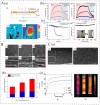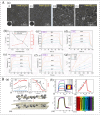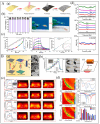The Advances in Polymer-Based Electrothermal Composites: A Review
- PMID: 40808096
- PMCID: PMC12349497
- DOI: 10.3390/polym17152047
The Advances in Polymer-Based Electrothermal Composites: A Review
Abstract
Polymer-based electrothermal composites (PECs) have been increasingly attracting attention in recent years owing to their flexibility, low density, and high electrothermal efficiency. However, although a large number of reviews have focused on flexible and transparent film heaters as well as polymer-based conductive composites, comprehensive reviews of polymer-based electrothermal composites remain limited. Herein, we provide a comprehensive review of recent advancements in polymer-based electrothermal materials. This review begins with an introduction to the electrothermal theoretical basis and the research progress of PECs incorporating various conductive fillers, such as graphene, carbon nanotubes (CNTs), carbon black (CB), MXenes, and metal nanowires. Furthermore, a critical discussion is provided to emphasize the factors influencing the electrothermal conversion efficiency of these composites. Meanwhile, the development of multi-functional electrothermal materials has been also summarized. Finally, the application progress, future prospects, limitations, and potential directions for PEC are discussed. This review aims to serve as a practical guide for engineers and researchers engaged in the development of polymer-based electrothermal composites.
Keywords: MXene; carbon nanotube; electrothermal conversion efficiency; electrothermal theoretical basis; graphene; polymer-based electrothermal composites.
Conflict of interest statement
The authors declare that they have no known competing financial interests or personal relationships that could have appeared to influence the work reported in this paper.
Figures












Similar articles
-
Short-Term Memory Impairment.2024 Jun 8. In: StatPearls [Internet]. Treasure Island (FL): StatPearls Publishing; 2025 Jan–. 2024 Jun 8. In: StatPearls [Internet]. Treasure Island (FL): StatPearls Publishing; 2025 Jan–. PMID: 31424720 Free Books & Documents.
-
The Black Book of Psychotropic Dosing and Monitoring.Psychopharmacol Bull. 2024 Jul 8;54(3):8-59. Psychopharmacol Bull. 2024. PMID: 38993656 Free PMC article. Review.
-
Systemic pharmacological treatments for chronic plaque psoriasis: a network meta-analysis.Cochrane Database Syst Rev. 2021 Apr 19;4(4):CD011535. doi: 10.1002/14651858.CD011535.pub4. Cochrane Database Syst Rev. 2021. Update in: Cochrane Database Syst Rev. 2022 May 23;5:CD011535. doi: 10.1002/14651858.CD011535.pub5. PMID: 33871055 Free PMC article. Updated.
-
Systemic pharmacological treatments for chronic plaque psoriasis: a network meta-analysis.Cochrane Database Syst Rev. 2020 Jan 9;1(1):CD011535. doi: 10.1002/14651858.CD011535.pub3. Cochrane Database Syst Rev. 2020. Update in: Cochrane Database Syst Rev. 2021 Apr 19;4:CD011535. doi: 10.1002/14651858.CD011535.pub4. PMID: 31917873 Free PMC article. Updated.
-
Management of urinary stones by experts in stone disease (ESD 2025).Arch Ital Urol Androl. 2025 Jun 30;97(2):14085. doi: 10.4081/aiua.2025.14085. Epub 2025 Jun 30. Arch Ital Urol Androl. 2025. PMID: 40583613 Review.
References
-
- Chuang D.D.L. Self-heating structural materials. Smart Mater. Struct. 2004;13:562. doi: 10.1088/0964-1726/13/3/015. - DOI
-
- Deng H., Lin L., Ji M., Zhang S., Yang M. QF Progress on the morphological control of conductive network in conductive polymer composites and the use as electroactive multifunctional materials. Prog. Polym. Sci. 2014;39:627–655. doi: 10.1016/j.progpolymsci.2013.07.007. - DOI
-
- An J.E., Jeong Y.G. Structure and electric heating performance of graphene/epoxy composite films. Eur. Polym. J. 2013;49:1322–1330. doi: 10.1016/j.eurpolymj.2013.02.005. - DOI
-
- Zeng Z., Jin H., Zhang L., Zhang H., Chen Z., Gao F., Zhang Z. Low-voltage and high-performance electrothermal actuator based on multi-walled carbon nanotube/polymer composites. Carbon. 2015;84:327–334. doi: 10.1016/j.carbon.2014.12.012. - DOI
Publication types
Grants and funding
LinkOut - more resources
Full Text Sources

